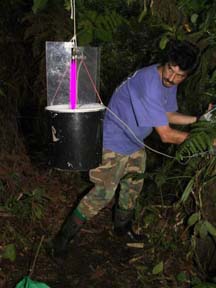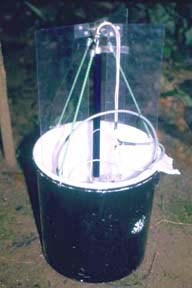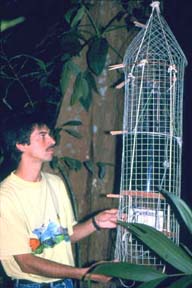|
Blacklight Samples
Group 1. Quantitative sampling, March 1993 to March 1994
Six sampling sites were chosen, as follows (GIS coordinates in parentheses):
Site 01: primary forest, CEN650 (679, -39).
Site 02: primary forest, CCL300 (900, 1411).
Site 03: second growth forest, SAT600 (1200, -230).
Site 04: lab clearing, nr library (553, 877).
Site 05: arboretum (900, 500).
Site 06: second growth forest, SOR750 (764, 1618).
At sites 1,2,3, and 6 a small shed was constructed, of two side poles and a roof of several sheets of tin. White sheets were hung beneath the sheds or, for sites 4 and 5, in the open. The usual procedure was for 4 ALAS staff to work in pairs, each pair sampling from two of the sites. The site pairs were 1 and 3, 2 and 6, 4 and 5. At each site, one blacklight was lit at about 1730hrs. When collecting commenced at a sheet, a regular white flourescent light was also lit. Hand collecting of focal taxa commenced at the first site at 1900hrs, and continued for about half an hour. The collectors then moved to the second site, and collected for 2 hours. They then returned to the first site for a final half hour of sampling, finishing by around 2200hrs.
Group 2. 27 June to 5 July 1994
A series of samples from various sites, during a visit by Jerry Powell.
Group 3. Quantitative sampling, 5 February to 1 May 1996
These samples used generally similar techniques to the quantitative samples of 1993-4, some of them at the same sites and some at new sites.
Group 4. May 1996
A series of samples from various sites, during a visit by Jerry Powell.
Group 5. Quantitative sampling using lighttraps, January 1998 to June 1999
Entotech light traps were used to carry out an 18-month program of sampling. These traps use a 8 watt blacklight tube surrounded by 3 transparent panes, all perched over a funnel on top of a bucket. The bucket has an internal smaller funnel and screen to allow water drainage from rain. The traps were surrounded by a larger wire cage, mesh size 0.5inch, to exclude large insects. Crumpled paper towels were placed in the bottom of the bucket, and a cloth bag of potassium or sodium cyanide suspended inside. The traps were placed before dusk and harvested the next morning. A light sensor turned the light on at dusk and off at dawn.
    
Traps were run in pairs, one suspended in the canopy about 20m high, and one on the ground beneath it. On each night of sampling, one trap pair was run. Trapping was carried out on two or three nights per week, rotating among 6 sites.
For 14 of the 372 individual samples, the trap malfunctioned and the flourescent tube did not light. A few specimens were sometimes captured regardless, so these collection codes have been retained in the database, but with a flag indicating that the light did not function.
The locations of the lighttraps was as follows:
Site number, location, GIS coordinates, canopy or ground
7, SOR750, 778, 1618, canopy
8, SOR750, 789, 1642, ground
9, CCC550, 1019, 898, canopy
10, CCC550, 1035, 876, ground
11, Arboleda, 896, 469, canopy
12, Arboleda, 881, 461, ground
13, CES350, 566, 464, canopy
14, CES350, 529, 485, ground
15, STR650, 0, 0, canopy
16, STR650, 0, 0, ground
17, STR2000, 912, -675, canopy
18, STR1800, 901, -664, ground
Material from a harvested trap was placed on a sorting tray. Macrolepidoptera were discarded. Large insects were separated by eye. The remaining material was examined under a dissecting scope. The residual material was stored in alcohol.
The following taxa were individually mounted and labeled: microlepidoptera (Tortricidae, Tineidae, Gracillaridae, Sesidae, and Choreutidae), Tettigoniidae, focal taxa of Braconidae, Symphyta, Scolytidae, Zygopinae, Buprestidae, Cleridae, Cerambycidae, focal taxa of Phoridae.
The following taxa were separated but left in alcohol: Syrphidae, Tachinidae, non-zygopine Curculionidae, large Coleopter, non-tettigoniid Orthopteroidea, non-focal taxon Hymenoptera (excluding Formicidae).
As a special project, Ronald Vargas separated and examined the males of Ecitoninae (Formicidae).
Non-lepidopteran material was washed in soapy water before mounting or transfer to alcohol.
Group 6. Miscellaneous
Miscellaneous blacklight sheet and trap samples, mostly from January 1998, when Jerry Powell was at La Selva and initiating the light trapping program.
Format of collection codes
Blacklight collection codes are of the form L/xx/xxx, where "L" indicates it is a blacklight sample, xx is a site code, and yyy is a unique blacklight sample number. Sample number is a sequential number based on all blacklight samples, starting in 1993, and not on the samples of a particular location or sampling period.
List of Collection Codes.
|







